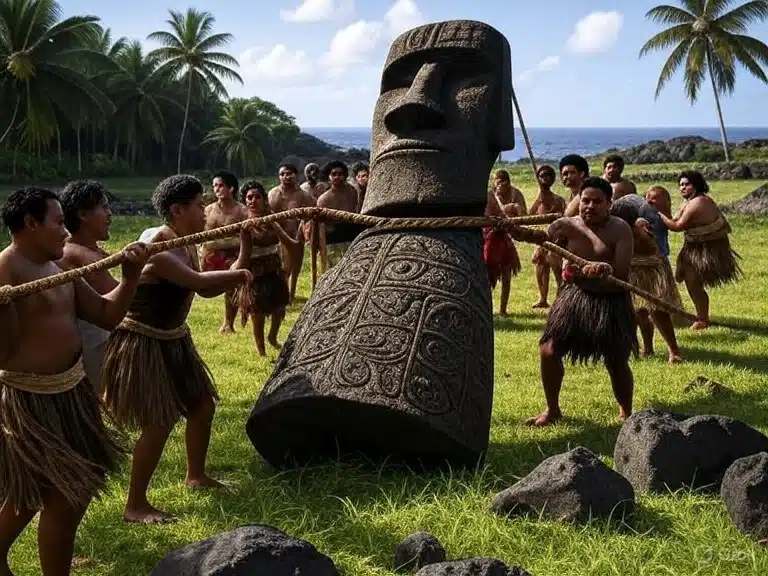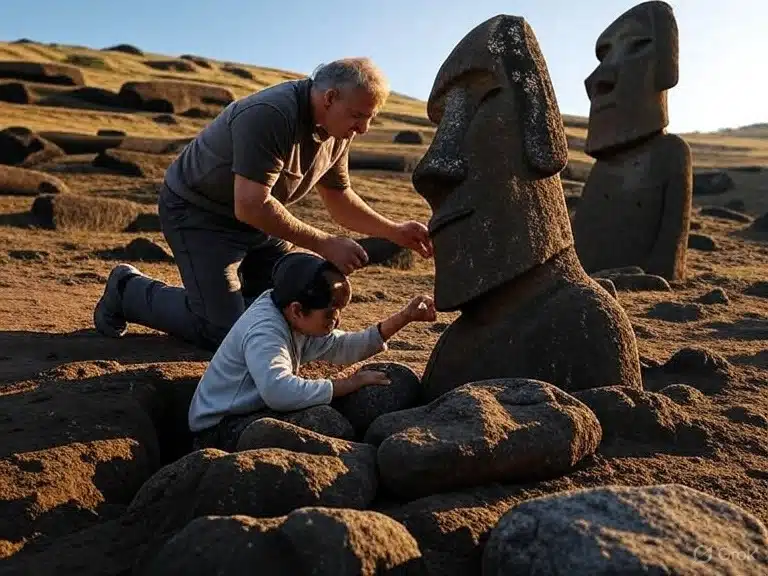A Mysterious Island in the Ocean
Far away in the vast Pacific Ocean lies a tiny island called Easter Island, also known as Rapa Nui. On this island stand nearly 1,000 gigantic stone statues called Moai. Each Moai is a giant head-and-torso statue, carved out of volcanic rock, some weighing as much as 80 tons!
But here’s the mystery: Who built them? Why did they build so many? And what happened to the people who once lived there?
The Moai statues are not just rocks—they are clues to a lost people. Let’s travel back in time, explore the island, and uncover the secrets of the Moai.
The Moai: Giants of Stone
When you first see a Moai statue, you can’t help but be amazed. These statues:
- Stand between 13 to 33 feet tall.
- Have large heads with long ears, big noses, and serious faces.
- Were carved from volcanic stone called tuff.
Some Moai also had red stone hats called “pukao,” which may have represented hair or crowns. Imagine a village of stone giants silently watching over the island!
The Moai were not just decorations. They represented ancestors and leaders, meant to protect and bring good fortune to the people of Rapa Nui.
How Were They Built?
This is one of the most exciting mysteries. The islanders did not have modern machines, cranes, or even wheels. So how did they carve and move such heavy statues?
Archaeologists believe the Rapa Nui people used stone tools to carefully chip away at the rock. Then, they somehow moved the Moai from the quarry to different parts of the island.
Here are some fascinating theories about how they moved them:
- Walking Theory – Some scientists think the Moai were “walked” upright using ropes, like waddling penguins.
- Log Rollers – Others believe wooden logs were used to roll the statues.
- Sledges and Ropes – Another theory suggests they dragged the statues on sledges.
Whichever way they did it, it shows that the Rapa Nui people were incredibly clever engineers.

Life of the Rapa Nui People
The people who built the Moai were called the Rapa Nui. They lived on the island starting around 1200 CE.
- They farmed sweet potatoes, bananas, and sugarcane.
- They fished in the ocean using canoes.
- They raised chickens and used stone ovens for cooking.
But life was not easy on Easter Island. It’s one of the most remote places on Earth, with no nearby land for hundreds of miles. The Rapa Nui had to depend on their own skills to survive.
The Moai were important in their culture. Each statue stood on a stone platform called an ahu, facing inland toward the villages. This showed that the ancestors were always watching over the people.
The Disappearance: What Happened to the Rapa Nui?
Just like the Indus Valley Civilization, Easter Island’s history is full of mystery. At some point, the Rapa Nui people stopped building Moai. Their society went through major changes. Why?
Scientists believe there are several reasons:
1. Deforestation
The island was once full of tall palm trees. These trees were cut down to make canoes, houses, and tools. Some may have been used to transport the Moai. Slowly, the forests disappeared. Without trees, the soil eroded, and farming became harder.
2. Resource Shortages
Without trees, the people struggled to build canoes for fishing or carry heavy loads. This may have led to hunger and fighting.
3. European Contact
In 1722, Dutch explorers arrived on Easter Sunday—giving the island its modern name, Easter Island. Later, European visitors brought diseases and slave raids, which badly hurt the population.
4. Civil War and Statue Toppling
Stories tell that rival clans fought each other. Many Moai were pushed over during these conflicts. Even today, some lie face-down on the ground.
The combination of all these problems caused the Rapa Nui society to collapse. From a thriving culture of thousands, only a small community survived.

What the Moai Teach Us
Even though the Rapa Nui people faced many challenges, the Moai statues remain as proof of their creativity and strength. They teach us important lessons:
- Respect Nature – The Rapa Nui used too many resources too quickly. This reminds us to protect our forests, oceans, and environment today.
- Teamwork – Moving such heavy statues required teamwork and clever planning. Working together can help solve big challenges.
- Remembering Ancestors – The Moai show how much people value their history and family.
The Mystery Still Lives On
Even today, scientists are still studying Easter Island. They use drones, satellites, and archaeology to answer questions like:
- How exactly were the Moai transported?
- Why were some statues left unfinished in the quarries?
- Did the statues really have deep bodies buried underground?
In fact, many Moai are not just heads—they have torsos hidden under the soil! Excavations have revealed carvings and symbols on their backs, adding more to the mystery.
Imagine if You Lived on Easter Island
Let’s play pretend! Imagine you are a Rapa Nui child living on Easter Island 700 years ago.
- You wake up in a small stone house and eat sweet potatoes for breakfast.
- You watch your parents farm the land and fish in the ocean.
- Then, you join the village to help carve a new Moai from volcanic rock.
- At night, you sit around the fire and hear stories of ancestors, while the Moai silently stand guard.
Doesn’t it sound like living in a giant outdoor museum full of history?
Conclusion: A Puzzle from the Past
The Moai statues of Easter Island are not just rocks; they are storytellers. They speak of a people who worked together, honored their ancestors, and left behind clues for us to discover.
Even though the Rapa Nui faced difficulties and their society changed forever, their spirit still lives in the Moai. These statues remind us that history is a puzzle—and every statue is a piece waiting to be understood.
So the next time you see a picture of Easter Island, remember: those stone giants are not just watching over the island, they are watching over the world’s imagination!

